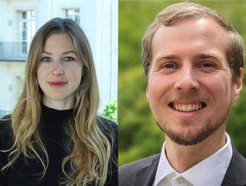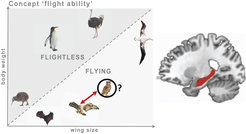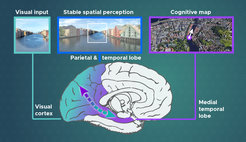Three questions to...
Stephanie Theves and Matthias Nau, this year’s winners of the Otto Hahn Medal.
The Max Planck Society honours young scientists and researchers each year with the Otto Hahn Medal for outstanding scientific achievements. This year, Stephanie Theves and Matthias Nau from the Max Planck Institute for Human Cognitive and Brain Sciences (MPI CBS) won two of the coveted awards.

Every year, the Max Planck Society honours some of the outstanding achievements of its doctoral students and postdocs at its annual meeting. This year marks the 40th anniversary of the award of the Otto Hahn Medal, with which the Max Planck Society honours its best young scientists. Like few others, Otto Hahn embodied scientific excellence and the pursuit of progress on a personal and societal level throughout his life. As President from 1946, he led the successful transformation of the Kaiser Wilhelm Society into the Max Planck Society.
This year, two scientists from the Max Planck Institute for Human Cognitive and Brain Sciences (MPI CBS) again received two of the coveted awards: Sophie Theves, who studies conceptual knowledge and intelligence, and Matthias Nau, who wants to understand how our visual perception and memory combine to form an inner image of the world. In three questions, they explain what it's all about.
Stephanie Theves, Department of Psychology
Your dissertation has just been awarded the Otto Hahn Medal. What makes your research so special?
My doctoral work was motivated by the question of how conceptual knowledge is acquired and represented in the brain such that we can flexibly use it, for example, to infer relations we’ve never directly experienced. The novelty of my approach was to investigate concept learning by integrating psychological theories of cognitive maps with insights from the physiology of spatial navigation. I examined whether hippocampal coding principles, which involve spatially-tuned cells that were originally considered to underlie our brain’s navigational system, support the formation of conceptual knowledge by integrating information into map-like representations. A map tells us how things are related to one another and allows to transfer knowledge about one instance to a related one. For instance, one might infer whether an unknown animal can fly based on its proximity to familiar examples in a space defined by relevant dimensions like body weight and wing size (cf. Figure).
In a series of experiments, I investigated how newly acquired concepts are represented in the brain by using functional magnetic resonance imaging (fMRI). In a first experiment, participants learned to categorize unfamiliar stimuli into two categories, based on the ratio of the stimuli’s two features. The concept of the two categories was thus defined in a two-dimensional feature space with its diagonal reflecting the category boundary, similar to my example of the concept ‘flight ability’. Using representational fMRI analyses, I demonstrated that the hippocampus encoded the distances between elements in concept space, i.e. mapped the concept space. Critically, such a map may only facilitate the extraction of meaning (e.g. the ability to fly) if it is defined along the relevant features, since meaningful clusters would get lost in a high-dimensional feature space. In a second experiment, I showed that the hippocampus ‘carves out’ concepts from the available features by integrating only the relevant dimensions in a map-like representation. In a final study, I turned towards the hierarchical nature of conceptual knowledge. This allows us to flexibly use it at different levels of abstraction, from coarse categories like ‘flying object’ to fine grained subcategories like ‘bats’. By comparing different learning models to categorization behavior and concurrent fMRI during a hierarchical concept learning task, I provided initial insights into the acquisition of multilayered structures in the hippocampal-prefrontal system.
In sum, by translating the framework of spatial maps to concept learning, my work contributed to a new neurocognitive perspective on how we extract commonalities and mark distinctions across experiences to build organized knowledge.
What is your motivation to work on this topic?
The ability to use an extremely rich, yet limited repository of knowledge flexibly and meaningfully to interpret novel situations and solve problems is a hallmark of human intelligence and still challenging to AI. I want to better understand how information is organized in the brain to allow for this key capacity. In this context, the interplay between memory representations and online reasoning processes makes concept learning such an interesting topic to me.
Furthermore, I am intrigued to understand human thinking at the level of key neural coding principles shared across cognitive domains (e.g. concept learning & navigation). This could potentially reveal a common basis for different mental operations and thus be relevant for explaining interindividual differences in cognitive ability.
The prize-winning thesis is in the bag. What’s next?
I’m currently continuing with my concept learning research as a postdoc at MPI CBS. Together with doctoral students, I investigate in more detail the mechanisms underlying the formation of concept spaces. In this context, we’re testing whether the updating of categorical boundaries to incorporate new exemplars can be explained by computational models of place cell population activity; and also whether the spatial nature of concept representations supports key features of concept learning, such as the abstraction of prototypes. Furthermore, I started to work on my new, longer-term research plan of exploring how these spatial codes, as well as the geometry of neural representations more broadly, relate to interindividual differences in reasoning ability and general intelligence.

A concept space illustrated by the example of the concept ‘flight ability’ (left). When arranging animals according to their wing size and body weight, the critical categories ‘flying’ vs ‘flightless’ emerge as regions in the 2D concept space. When participants learn novel concepts in an experimental setting (cf. Theves et al., Current Biology 2019) the hippocampus (right) encodes the feature-based distances (cf. red arrow) in concept space.
Matthias Nau, Department of Psychology
Your dissertation has just been awarded the Otto Hahn Medal. What makes your research so special?
I am fascinated by how our brain combines vision and memory to form an internal image of the external world and how this guides our behavior. My research follows this fascination with the help of functional neuroimaging, eye tracking and machine learning. In my dissertation, I specifically address the question of how our brain perceives the many visual stimuli in our environment, how it combines them into unified impressions of space, and how these are integrated into our memories in the form of a cognitive map.
In a first study, I examined how our brain performs a form of image stabilization. Without it, our vision would blur every time we move. Our brain, however, circumvents this by integrating our own movements with the signals coming from the retina - and we showed that even the earliest visual regions in the brain’s cortical hierarchy contribute to this process. In a second study, I then studied how higher-level regions involved in memory formation map our environment. I was particularly fascinated by the role of visual grid cells, which encode a coordinate system of visual space in the animal model. We were able to show that this coordinate system also exists in the human brain, forming an important bridge between our current perception, our gaze behavior and our memories. In a third study, I subsequently examined how visual and memory regions work together when we explore and memorize a new environment. By leveraging virtual reality and specifically developed model-based analyses, we demonstrated that the ongoing memory formation directly influences how our brain processes visual information. My work thus combines ideas and methods from different neuroscientific research fields in order to gain deeper insights into the neural underpinnings of spatial vision and memory formation.

What is your motivation to work on this topic?
As a cognitive neuroscientist, I work at the exciting intersection between biology, psychology, computer science, medicine, physics and philosophy. I have the huge privilege of learning something new about all these fields on a daily basis and gaining in-depth insights into human brain function. This interdisciplinary exchange and the feeling of contributing to something bigger is incredibly rewarding. Moreover, not only does neuroscientific research generate new knowledge and the basis for medical applications, but it actively shapes our very understanding of ourselves as humans. Motivation comes naturally.
The prize-winning thesis is in the bag. What’s next?
I am continuing my research as a postdoc at the National Institutes of Health in Bethesda (USA) supported by a fellowship from the Alexander-von-Humboldt foundation. Here, I study the role of eye movements in memory recall and mental imagery. For example, when we imagine standing in our kitchen, our eyes move more or less as if we were actually standing there. Based on my past research, I am convinced that this “replay” of eye movements during memory recall directly relates to reactivations of specific neuronal activity patterns in sensory and memory regions. The interplay between motor and sensory functions in the brain that guides our perception of the environment may thus also enable us to re-experience it in front of our mind’s eye.





